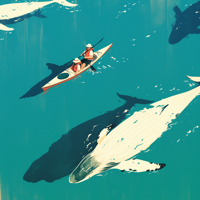 California sea kayakers are getting up-close and personal with humpback and grey whales, Tom Stienstra reports for SFGate:
California sea kayakers are getting up-close and personal with humpback and grey whales, Tom Stienstra reports for SFGate:
The kayakers floated on a calm sea, quiet and nearly motionless – and yet were edgy at what might happen next.
In the next moment, a 40-foot humpback whale rose up through the surface alongside the paddlers, its open mouth gushing with seawater and dripping with anchovies. The whale then crashed into the water with a giant splash that drenched the paddlers.
For a paddler, having a whale rising up next to you is like sitting in an electric chair, not a kayak.
In the past few weeks, paddlers are agog in Santa Cruz, Capitola and Aptos as whales have provided kayakers close-range encounters, lunge feeding with breaches, tail slaps, pectoral waves and chin slaps.
“You just hang out and the whales come right up to you,” said Giancarlo Thomae, a naturalist, marine biologist and photographer who captured the big show on camera. A 22-photo gallery of recent photos is posted at www.sfgate.com/outdoors.
Out of Moss Landing in Monterey Bay, Thomae counted 50 humpback whales two weeks ago a short distance offshore. Last week, as the humpbacks started their migration to the wintering grounds off Baja, about 15 whales, primarily mothers with their calves and a few yearlings, remained within 2 miles of shore.
Rich marine food production has set off what seems a golden age for the old sea. The humpbacks are feeding on vast swarms of anchovies and other food in Monterey Bay, near San Francisco in the Gulf of the Farallones National Marine Sanctuary and at points north off Bodega Bay.
“Right now it’s the anchovies,” Thomae said. “You see them shimmering in the water.”
Gray whales are expected to join the show in the coming weeks along the California coast. That will feature a mass cruise along the Bay Area as they start their migration south. From coastal lookouts, their spouts will look like little puffs of smoke.
Note that it is a violation of ethics and federal law to approach the whales within 100 yards or otherwise change their behavior. What kayakers and boaters alike have discovered is that once you’re in range, you can turn off your engine – whether it be motor-powered or human-powered. Instead of you going to the whales, they come to you.
You can read the whole story HERE.

